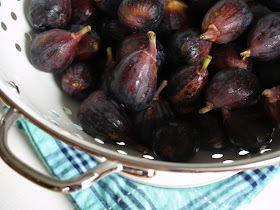I've been making strawberry shortcake since college, when each summer one of our professors, Mary Saunders, would invite a group of us students to a barbeque at her home in beautiful Manchester, Massachusetts. Year after year it became a tradition for all of us to take the train from Boston, and visit with her in the quint New England seaside town. I always made sure to bring along some freshly baked shortcakes, strawberries, and homemade whipped cream for dessert. Mary would always say, "Michael, it's not everyday you get homemade whipped cream." And you know what, she's right! This dessert is always a treat, and one that I look forward to every season.
Strawberry shortcake, not to be confused with the animated character or the English-style cookie, is a beloved classic American spring and summer dessert. However, the first published recipe for "shortcake," a type of unleavened cookie, dates back to 16th century England when it appeared in an Elizabethan cookbook. Several centuries later on the other side of the Atlantic ocean, shortcake has become more akin to a biscuit than a cake or cookie. In 19th century America, baking soda was introduced and the rest is history.
My shortcake recipe has evolved a lot over the past few years, but I finally think I've got it just right. To be honest, I'm not even sure where the original recipe originated. The shortcake is not too sweet, letting the strawberries and cream really shine. It's nice and crumbly, and absorbs all of the delicious moisture provided by the berries, without becoming soggy or mushy. It's just a reminder that sometimes the simplest things are the most delicious. It's no wonder it remains a beloved American classic after all these years.
STRAWBERRY SHORTCAKE
Ingredients:
For the strawberries
2 pounds fresh strawberries, washed, hulled, and quartered
1/4 cup sugar
For the shortcakes
2 cups all-purpose flour
2 teaspoons baking powder
1/4 teaspoon baking soda
3/4 teaspoon kosher salt
3 tablespoons sugar
5 tablespoons cold unsalted butter, cut into 1/2-inch pieces
1 1/4 cups heavy cream, plus more as needed
Sparkling sugar, as needed (optional, see notes below)
For the whipped cream
1 1/2 cups heavy cream
1/4 cup plus 1 tablespoon sifted confectioner's sugar
1 teaspoon vanilla extract
For the strawberries
Put the strawberries in a medium bowl and toss with the sugar. Cover and refrigerate until ready to use.
For the shortcakes
Preheat the oven to 425 degrees F. Line a sheet pan with parchment paper or a Silpat and set aside.
Sift together the flour, baking powder, baking soda, salt, and sugar over a large bowl and whisk to combine. Add the butter to the dry ingredients, toss with the flour, and rub it between your fingers to blend it with the flour. It should resemble coarse sand.
Pour the buttermilk in all at once and stir with a wooden spoon until the mixture just comes together. The dough should hold together nicely and still be slightly sticky. Drop the dough by spoonfuls onto the prepared sheet pan (for large shortcakes evenly divide the dough among 6 scoops, for smaller shortcakes, evenly divide the dough among 8 scoops). Lightly brush the tops of the shortcakes with heavy cream and sprinkle with sparkling sugar, if desired. Place the pan in the oven and bake for 15 to 20 minutes, until the tops are lightly golden brown and a toothpick inserted into the center comes out clean. Transfer the shortcakes to a drying rack to cool. Serve within an hour or two after baking, for them to be at their best.
For the whipped cream
Place a mixing bowl and whisk attachment (or whisk) in the freezer for 10 to 15 minutes to chill. Remove the bowl from the freezer and add the heavy cream, confectioner's sugar, and vanilla extract. Whip the cream on medium speed using an electric mixer (or by hand if you want the workout) until soft peaks form. Cover with plastic wrap and place in the refrigerator until ready to use.
Assembly
Using a serrated knife, carefully cut the shortcakes in half. Place the bottom potion of the shortcake on a plate and spoon on some of the sweetened strawberries, being sure to add some syrup that has accumulated at the bottom of the bowl. Add a couple of spoonfuls of freshly whipped cream to the strawberries. Place the top portion of the shortcake on top. Repeat with the remaining shortcakes and serve immediately.
6 to 8 servings
Notes:
- Sparkling sugar is a type of coarse-grain sugar that can be found at most cake and baking supply stores, or online.

































